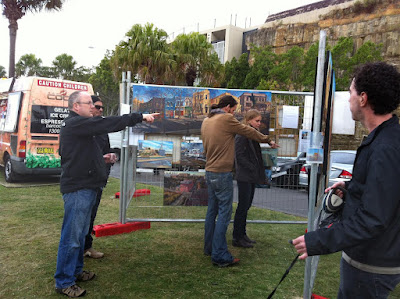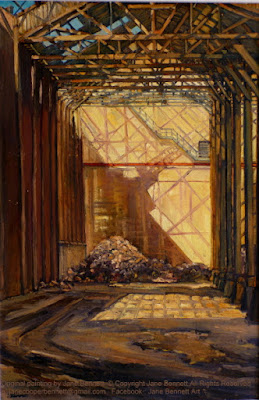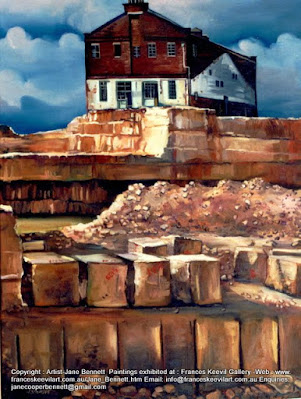
Exhibition of paintings of Pyrmont by Jane Bennett
at the 2012 Pyrmont Festival
Enquiries
janecooperbennett@gmail.com
The photos of the display are courtesy of Frances Keevil, who also very kindly took time out from the gallery to hang and help me label the work. If not for Frances I'd probably still be there trying to cable tie canvases onto the security fence. It was still a nightmare to hang, and having to cable tie extremely valuable and historic paintings to a security fence is far from ideal.
The artworks are at risk of being damaged, and so was I. Due to the unfortunate timing of the Sydney half marathon being run on the morning of the event and the roads being closed as a consequence, there was very little time to unload my art and hang it.

Exhibition of paintings of Pyrmont by
Jane Bennett at the 2012 Pyrmont Festival
Enquiries
janecooperbennett@gmail.com
I had brought 50 paintings on canvas and board for the exhibition. The largest was a 61 x 183cm canvas of a panorama of "Union Square" and the smallest was a tiny work on board of a detail of a window of the Terminus Hotel that at 9 x 13cm could fit in the palm of your hand.

Exhibition of paintings of Pyrmont by
Jane Bennett at the 2012 Pyrmont Festival
Enquiries
janecooperbennett@gmail.com
This shows a couple of paintings of the CSR with some information sheets about my experiences creating them.
I also brought a small folio of works on paper, most of which had never been previously exhibited.

Exhibition of paintings of Pyrmont by
Jane Bennett at the 2012 Pyrmont Festival
Enquiries
janecooperbennett@gmail.com
Despite the rain we had a good audience. I met lots of people who once lived or worked in Pyrmont as well as many of the new residents of Jacksons Landing and the apartments on top of Pyrmont Point.
I am now trying to complete 6 commissions resulting from contacts made on this day.

Exhibition of paintings of Pyrmont by Jane Bennett
at the 2012 Pyrmont Festival
Enquiries
janecooperbennett@gmail.com
This shows a corner of my stall. I'm glad I decided to add this to my allotted space on the security fence, as the stall gave a little shelter from the rain, and I wouldn't have been able to display my books or photos of the rest of my work otherwise.
But the stall and the fence for the daily cost $220, which Ned Kelly would have been ashamed of.
Pyrmont Point was once the site of no less than 5 of my studios. Had the earlier businesses and residents of Pyrmont been as greedy, I wouldn't have been able to create any of the paintings that the current residents enjoy.
Wood if I could...

Table easel made of recycled timber by artist Jane Bennett
I had made eleven small table easels in the weeks before as preparation for the event. Small paintings would get lost on the fencing next to larger works, and it freed up space for sheets of information about my series of Pyrmont paintings. The historical context is becoming more and more important as time goes by and the new residents seek information about their area.

Table easel made of recycled timber by artist Jane Bennett
I'm no carpenter - in fact I've very rarely picked up a hammer or screwdriver in my life before. I had bought a couple of little easels, but they were fairly useless. They tended to collapse or fall over easily - not a good look in a public exhibition. I couldn't find anything that would serve my purpose in the art shops they were either far too big or small, much too expensive, or had useless fiddly bits that would soon snap off or stab an expensive painting in the back.
I was sick of playing "Goldilocks" so I decided to try my hand at making what I needed despite a total lack of skill, knowledge, experience or the correct tools or materials.
I used some bits of scrap wood I found lying around the garden.
"Recycled" is probably too kind a word for it, "rubbish" is closer to the mark. It was a motley collection salvaged from a warped canvas stretcher,part of an old fence, a couple of garden stakes and a rotting pallet that a neighbour put out for council clean-up. But once I had sanded them and covered up the wonky bits with wood stain they scrubbed up quite well.
These "easels" are just simple A frame tripods. I didn't even attempt to make them with adjustable heights. which I knew was well beyond my almost non-existent woodworking abilities. Also most of my easels with adjustable heights have some major design flaw anyway that makes them hell to use.
These are simply to prop up a small to medium size painting so it can be seen with a bit of dignity at an event where there is no hanging system, and very limited time to prepare the display.
No two of them are the same size or shape. I practice saying "quirky rustic charm" a lot.

"Terminus Hotel" displayed on a Table easel
made of recycled timber by artist Jane Bennett
2010 oil on canvas 31 x 31cm
Enquiries
janecooperbennett@gmail.com
But they do the job.
The red cedar woodstain especially suited the Terminus Hotel paintings, as it picked up the burnt siena of the ivy -covered bricks.

oil painting of "Gargoyle on spire of
Maclaurin Hall, University of Sydney"
displayed on a Table easel made of recycled timber
2009 oil on board 25 x 20cm
Enquiries
janecooperbennett@gmail.com
This shows my painting of "Gargoyle on spire of Maclaurin Hall, University of Sydney" displayed on a table easel that I made from parts of a shabby old frame that had warped and had to be removed. Unfortunately I discovered at the festival that the white paint blistered in the rain, so I have now taken it apart, sanded it back and given it a coat of the same red cedar wood stain so it now matches the others.
For more information see My Pyrmont page in this blog
Related posts
Looking over the overlooked-Urban decay in Pyrmont
To the Point
Wrong side of the tracks - Darling Island Bond and Free
Pretty vacant A Tale of two hotels - the Terminus and the Point
Pyrmont Paintings past and present
Paintings of Pink pubs - Painting the Jolly Frog Part 2













